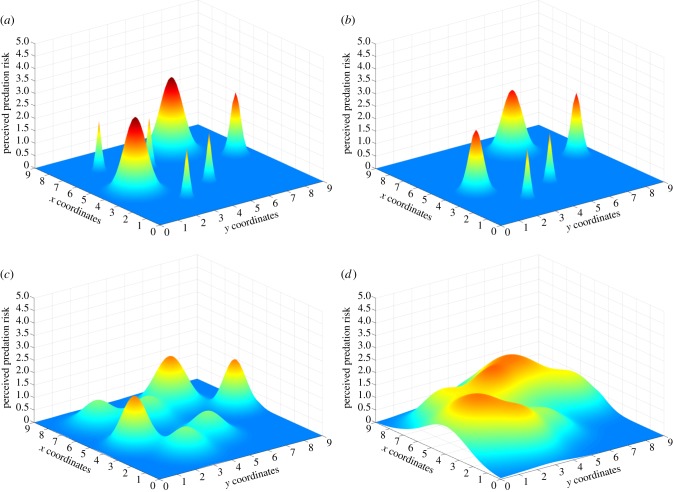Figure 2.
(a) The distribution of a hypothetical predator across space. The presence of predators can create a ‘landscape of fear’ [8], altering the behaviour of prey. The landscape of fear, however, will vary with the ability of prey to perceive the presence of predators, but not all prey and not all sensory modalities sense predators in the same way. (b) The perceived presence of predators by prey that detect predators through the visual modality. Vision gives accurate information about the presence of a predator when it is seen. It relies on direct line of sight, so detection rate can be lower than in other modalities (the prey might not see all the predators in its visual field) and the size of the detection field is typically smaller than in other modalities, but the information about spatial location is more accurate. Note that compared with (a) the peaks in (b) are lower (fewer predators are detected than are actually present), the area of the base of the peaks is smaller (the visual field does not encompass the entire landscape), but the gradient is still steep (i.e. greater accuracy of information). (c) The perceived presence of predators by prey that detect predators through the auditory modality. Sound gives less accurate information about location than visual cues, but because a direct line of sight is not required predators can be detected by acoustic cues over a larger distance than visual cues. Sound is only emitted by the predator when it moves and when it voluntarily makes sound, such as in acoustic communication. Thus, compared with (b) the height of the peaks (predators detected) could be lower if predators tend to be silent, the areas around the peaks are larger (the acoustic detection field is larger than the visual detection field), and the peaks are less steep (the accuracy of localization information is lower). (d) The perceived presence of predators by prey that detect predators through the olfactory modality. Here, we assume that odours are deposited by a predator to mark its territory or home range and thus are non-volatile. Odours provide accurate information about where an individual was but almost no information as to where it is, and this information cannot be detected at any substantial distance from the odour source when odours are used for marking (unlike long-distance olfactory communication in moths and some other animals). Thus, compared with (c) the peaks are high (many prey are detected), the area over which prey can be detected is small and restricted to be within the actual range of the predator (unlike with visual and especially auditory cues when a predator can be detected from a prey outside of its range), and the peaks are not at all steep since the information about the where a predator is at the time the odour cue is sensed in not very accurate. (Online version in colour.)

